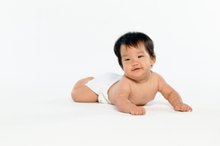Symptoms of Tourette's in Babies
Tourette’s Syndrome is a neurological disorder named for a French neurologist who described the condition in 1885. The disorder causes tics, which are involuntary movements, speech and sounds. Males are more likely to have Tourette than females and the condition affects all ethnic groups. Although the symptoms of Tourette Syndrome appear in children when they are about 3 years old, the average age of onset ranges between 7 and 10 years of age 2. With increased knowledge of the condition, some parents question whether certain behaviors exhibited by their babies might indicate Tourette Syndrome.
Causes
Research shows Tourette Syndrome to be a genetic condition in most cases that is possibly related to obsessive-compulsive disorder and attention deficit hyperactivity disorder. Some children acquire Tourette’s through non-genetic means, such as problems during pregnancy or head trauma during infancy. Although babies may be born with Tourette Syndrome, there is little information about symptoms of the condition that babies might experience.
Symptoms
Diet for Kids With Tics
Learn More
The symptoms attributed to Tourette Syndrome are those experienced by older children and adults 2. The repetitive tics that are characteristic of the condition are classified as motor and vocal. Simple tics involve a few muscle groups, while complex tics involve several muscle groups. Motor tics usually begin first, starting in the head and neck, with vocal tics following. Motor tics include grimacing, blinking, shrugging, twisting and jumping. Vocal tics include throat-clearing, grunting, barking and shouting words.
- The symptoms attributed to Tourette Syndrome are those experienced by older children and adults 2.
- Motor tics usually begin first, starting in the head and neck, with vocal tics following.
Onset of Symptoms
Infants are mostly non-verbal and just learning to control their bodies, which makes it a challenge to detect Tourette’s symptoms. Some doctors believe that tics during infancy might indicate Tourette’s Syndrome, according to a research study performed by Samuel Zinner, M.D. and published in the “Interdisciplinary Journal of Early Childhood Intervention” in 2006 4. Children with Tourette Syndrome usually begin to exhibit symptoms around 3 years of age, according to FamilyDoctor.org 2. Symptoms usually begin with motor tics in the head and neck. The motor ticks sometimes progress to the rest of the body.
- Infants are mostly non-verbal and just learning to control their bodies, which makes it a challenge to detect Tourette’s symptoms.
Delayed Diagnosis
Infant Seizures Signs & Symptoms
Learn More
Doctors generally do not diagnose Tourette Syndrome until a patient has exhibited both vocal and motor tics for at least one year 2. The diagnosis may be delayed in many cases because parents assume that tics such as eye blinking, sniffing or throat clearing are caused by allergies or other illnesses. Parents also may believe that the behaviors are a normal part of the child’s development. For many patients, diagnosis of the syndrome occurs long after the symptoms first appear. Doctors may use family history and genetic counseling to help diagnose Tourette’s.
- Doctors generally do not diagnose Tourette Syndrome until a patient has exhibited both vocal and motor tics for at least one year 2.
- The diagnosis may be delayed in many cases because parents assume that tics such as eye blinking, sniffing or throat clearing are caused by allergies or other illnesses.
Related Articles
References
- FamilyDoctor.org: Tics and Tourette’s Syndrome in Children
- “Interdisciplinary Journal of Early Childhood Intervention;” Samuel Zinner, M.D.; Tourette Syndrome in Infancy and Early Childhood;.2006
- Centers for Disease Control and Prevention. What Is Tourette Syndrome?. Updated June 12, 2020.
- American Psychiatric Association: Diagnostic and Statistical Manual of Mental Disorders, 5th edition. Arlington, VA., American Psychiatric Association, 2013.
- National Alliance on Mental Illness. Tourette’s Syndrome Fact Sheet. Updated September 2012.
- National Institutes of Health. Tourette Syndrome Fact Sheet. National Institute of Neurological Disorders and Stroke. Updated March 17, 2020.
- Caligiore D, Mannella F, Arbib MA, Baldassarre G. Dysfunctions of the basal ganglia-cerebellar-thalamo-cortical system produce motor tics in Tourette syndrome. PLoS Comput Biol. 2017;13(3):e1005395. doi:10.1371/journal.pcbi.1005395
- Tourette's Association of America. Co-Occurring Conditions.
- Centers for Disease Control and Prevention. Tourette Syndrome Treatments. Updated May 13, 2020.
- Kenney C, Kuo SH, Jimenez-Shahed J. Tourette’s syndrome. American Family Physician. 2008;77(5):651-658.
Writer Bio
Gail Sessoms, a grant writer and nonprofit consultant, writes about nonprofit, small business and personal finance issues. She volunteers as a court-appointed child advocate, has a background in social services and writes about issues important to families. Sessoms holds a Bachelor of Arts degree in liberal studies.









